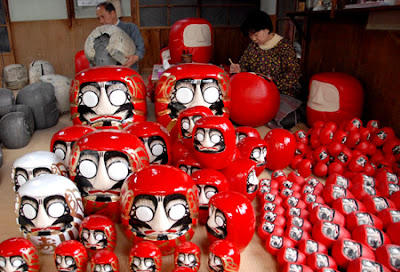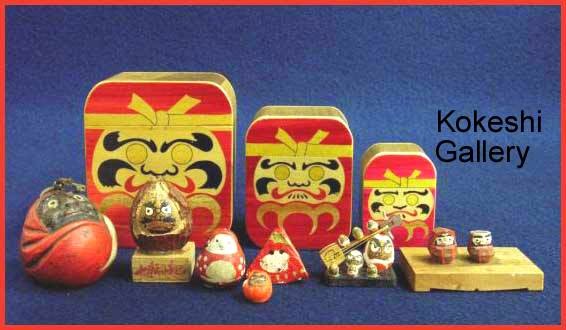:::::::::::::::::::::::::::::::::::::::::::::::::::::::::::::::::::::::::::::::::::::::::::::::::::::
Princess Daruma from Takeda 竹田の姫達磨
Komatsu Nyoin Daruma 小松女院だるま
:::::::::::::::::::::::::::::::::::::::::::::::::::::::::::::::::::::::::::::::::::::::::::::::::::::
Princess Daruma from Takeda 竹田の姫達磨

She reminds us of the diligent wife of the samurai
Zaika Kanzaemon 雑賀勘左ヱ門 of the Oka clan in the old province of Bungo in Kyushu.
Once upon a time more than 300 years ago, there was the young girl Aya, wed into a Samurai family and thrown out of the house by her unfriendly mother in law on an icecold winter night. She had to stay in a shed braving cold and hunger for two days and was rescued by her husband just in time. The mother in law heard the story and came to see Aya, tears in her eyes and remorse for her harsh behaviour and from that day on the family lived happily together.
The diligence of Aya became the model for a tumbler doll in the fashion of Daruma, since he is the model for diligence too, meditating nine years in a cave. She is also called
Takeda Onna Daruma, the Lady Daruma of Takeda.
Aya endured spiritual and emotional conflict and found peace through living a pure and noble life. Words of the artist Mrs. Gotoo: "We can achieve a happy life by devoting ourselves to selfless love of others. I believe that if one can reach the state of this Himedaruma, one will be able to enjoy a life filled with good luck. A life without peril; in wich one's family is happy and one's business is fruitful."

This Princess Daruma or Lady Daruma is one of the specialities of Oita prefecture and of course the village of Takeda. It is sold at various places throughout this area, especially at the souvenir shops at Oka castle. This doll is also called the "Roly-Poly Doll of Takeda", Takeda no Okiagari 竹田の起き上がり, but since 1931 it is usually called "Princess Daruma".
.................................................................................
This papermachee doll is also called
"Lucky Lady" (fukuonna 福女) and her face is really pretty. During the second night of the New Year, young people of the town of Takeda start running through the village at the cry of the cock and throw small Lady Daruma Dolls in the entrance of the homes. So all homes will have a lot of good luck during the coming year.

The small doll of the following picture was made by the first producer of this doll, Mrs. Gotoo, the bigger one by her daughter. If you cover the mouth of the bigger doll, the facial expression will change and she looks like crying. The face of the smaller one does not change if you cover any part, it will always look full of happiness. Maybe it is the rendering of the face of her daughter, who was still a young child when Mrs. Gotoo made this one.
Gotoo Himedaruma Store
source : 後藤姫だるま工房 大分県竹田市吉田889-1

:::::::::::::::::::::::::::::::::::::::::::::::::::::::::::::::::::::::::::::::::::::::::::::::::::::
"On the back of this kind-looking lady
we find a picture of the male symbol Hohoho....!"
優しい顔の背中に男性のシンボルが描かれています。 ぎょ!ぎょ!

:::::::::::::::::::::::::::::::::::::::::::::::::::::::::::::::::::::::::::::::::::::::::::::::::::::
Komatsu Nyoin Daruma 小松女院だるま

Made by Ogawa Shuuta 小川秀太 from Kusu village.

Once upon a time in the Heian period
the grandchild of Daigo Tenno named Lady Komatsu Nyoin 小松女院 fell in love with a samurai of low rank from the Bungo province and followed him into exile to Bungo.
His name was Kiyohara Masataka 清原正高 (some say he was the brother of Sei Shonagon).
When she arrived in Bungo, she found out that he was already married and she and her fellow ladies threw themselves into the waterfall Mikazuki no taki 三日月の滝 to die.
The pine where she deposited her stick and straw hat are still there.
kasakake no matsu 笠掛けの松.

Mikazuki waterfall in the shape of a crescent moon
大分県玖珠郡玖珠町山浦
The Bungo Kiyohara Family 豊後清原一族 When Emperor Daigo found out that Masataka had been with his grandchild, Komatsu, he banned him to Tajima and leter to Bungo. In 973 he arrived by ship in Hiji no shoo 日出庄 and made his way to Kusu village 久兼. He became involved with the daughter of a local regent and married her. Eventually the emperor forgave him and he could move back to Kyoto.
:::::::::::::::::::::::::::::::::::::::::::::::::::::::::::::::::::::::::::::::::::::::::::::::::::::
. Onna Daruma 女だるま Daruma as a Woman .
. Oita Folk Art - 大分県 .
[ . BACK to DARUMA MUSEUM TOP . ]
[ . BACK to WORLDKIGO . TOP . ]
:::::::::::::::::::::::::::::::::::::::::::::::::::::::::::::::::::::::::::::::::::::::::::::::::::::

















































